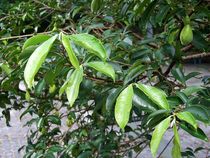
Picture of the has been licensed under a GFDL
Original source: Own work
Author: Chong Fat
Permission: GNU Free Documentation License
Original source: Own work
Author: Chong Fat
Permission: GNU Free Documentation License
Aquilaria sinensis
Description: Aquilaria sinensis belongs to the plant family Thymelaeaceae. It is an evergreen tree, 6 to 20 m tall. The smooth bark is grayish to dark grey, and the wood is white to yellowish – so giving it another Chinese name “Pak Muk Heung” . Its branchlets are sparsely covered with hairs when young. Its leaves are alternate, leathery, obovate to elliptic, generally 5 to 11 cm long and 2 to 4 cm wide, with 15 to 20 pairs of inconspicuous and nearly parallel lateral veins which is a helpful diagnostic feature in the field. The apex of each leaf is short acuminate and the base is broadly cuneate, with entire and smooth margins. Its flowers are yellowish green, fragrant, in a terminal or axillary umbel. The fruit is a woody obovoid capsule with an outer covering of short grey hairs, 2.5 to 3 cm long, opening in two flat valves when ripen. When the fruit is open, a silky thread from the base of the fruit holds the single seed in the air.Aquilaria sinensis is a species of plant in the Thymelaeaceae family. It is endemic to China. It is threatened by habitat loss. This medicinal plant is a source of fragrant wood, formed under a pathological condition, called Chen Xiang (Chinese: ??) or agarwood. Contents - * 1 Uses * 1. More
* Aquilaria sinensis, found in China * Aquilaria subintegra, found in Thailand Conservation of Agarwood-producing Species - Overharvesting and habitat loss threatens some populations of agarwood-producing species. More
